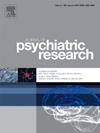Electrophysiological effects of deep brain stimulation in anorexia nervosa
IF 3.7
2区 医学
Q1 PSYCHIATRY
引用次数: 0
Abstract
Objective
To study deep brain stimulation (DBS)-induced electrophysiological changes over time in patients with anorexia nervosa (AN).
Methods
We performed EEG recordings on 4 AN patients treated with DBS at 3 time points, and on 8 age-matched controls. We extracted oscillatory power in the alpha and beta bands, connectivity and global network organization parameters based on graph theory.
Results
We found strong significant within-subject changes in alpha and beta power over time. Nominally significant effects were observed for posterior left (L) alpha (p = 0.034) and anterior/posterior L scalp areas (p = 0.034 and p = 0.013, respectively), however, multiple testing indicated that the effects are heterogeneous across subjects. We found V-shaped curves over time for average functional connectivity. This was largely re-established at the final time-point. The graph-theoretical measures showed similar V-shaped effects consistent with an initially disordered network state.
Conclusion
Within-subject effects of stimulation were large, widespread over frequencies, and visible across wide brain areas and networks. Prolonged stimulation seemed to reinstate organization in the functional brain networks. Our results support the observations that effects of DBS are not merely local, but influence widespread pathological network activity and that, after an initial period of disorganisation, the brain adapts to the stimulation.
Significance
A better understanding of the electrophysiological effects of DBS may allow us to personalize and optimize the intervention and thereby further improve effectiveness in AN.
脑深部电刺激对神经性厌食症的电生理影响
目的 研究深部脑刺激(DBS)引起的神经性厌食症(AN)患者电生理学随时间的变化。我们提取了阿尔法和贝塔波段的振荡功率,以及基于图论的连接性和全局网络组织参数。在左后方(L)α(p = 0.034)和左前方/后方头皮区域(分别为 p = 0.034 和 p = 0.013)观察到了名义上的显着效应,然而多重测试表明,不同受试者之间的效应是不同的。我们发现,随着时间的推移,平均功能连接呈 V 型曲线。在最后一个时间点,这种曲线基本重新确立。图论测量显示了类似的 V 型效应,与最初的紊乱网络状态一致。长时间的刺激似乎恢复了大脑功能网络的组织。我们的研究结果支持这样的观点,即 DBS 的效应不仅仅是局部的,而是会影响广泛的病理网络活动,而且在经历了最初的紊乱期后,大脑会适应刺激。意义更好地了解 DBS 的电生理效应可使我们对干预措施进行个性化和优化,从而进一步提高对自闭症的疗效。
本文章由计算机程序翻译,如有差异,请以英文原文为准。
求助全文
约1分钟内获得全文
求助全文
来源期刊

Journal of psychiatric research
医学-精神病学
CiteScore
7.30
自引率
2.10%
发文量
622
审稿时长
130 days
期刊介绍:
Founded in 1961 to report on the latest work in psychiatry and cognate disciplines, the Journal of Psychiatric Research is dedicated to innovative and timely studies of four important areas of research:
(1) clinical studies of all disciplines relating to psychiatric illness, as well as normal human behaviour, including biochemical, physiological, genetic, environmental, social, psychological and epidemiological factors;
(2) basic studies pertaining to psychiatry in such fields as neuropsychopharmacology, neuroendocrinology, electrophysiology, genetics, experimental psychology and epidemiology;
(3) the growing application of clinical laboratory techniques in psychiatry, including imagery and spectroscopy of the brain, molecular biology and computer sciences;
 求助内容:
求助内容: 应助结果提醒方式:
应助结果提醒方式:


